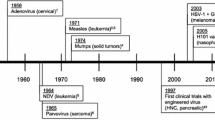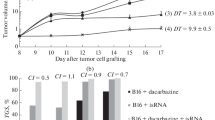Summary
We have previously shown that the in vivo administration of ABPP, an interferon inducing pyrimidinone, generates activated killer cells that can lyse fresh tumor cells in vitro in 4-h 51chromium release assays. The administration of this agent however has no effect on established tumor. In this communication we show that ABPP, when used in combination with low or moderate doses of cyclophosphamide, can be quite effective against early established (day 3) tumor as well as against advanced, grossly visible (day 8–10) tumor in both the i.p. and pulmonary metastasis model. The synergistic antitumor activity of this cheoimmunotherapeutic regimen was very strong against immunogenic tumors but rather weak against nonimmunogenic tumors. Two treatment cycles were significantly more effective than one and multiple cycles even cured the majority of mice with established i.p. tumor. These experiments demonstrate the potential of chemoimmunotherapeutic regimens and highlight the efficacy of multiple treatment cycles.
Similar content being viewed by others
References
Anderson RE, Standefer JC, Tokuda S (1986) The structural and functional assessment of cytotoxic injury of the immune system with particular reference to the effects of ionizing radiation and cyclophosphamide. Br J Cancer 53 (Suppl VII):140–160
Bast RC, Bast BP (1976) Critical review of previously reported animal studies of tumor immunotherapy with non-specific immunostimulants. Ann NY Acad Sci 277:60–93
Bear HD (1986) Tumor specific suppressor T-cells which inhibit the in vitro generation of cytolytic T-cells from immune and early tumor bearing host spleens. Cancer Res 46:1805
Eggermont AMM, Steller EP, Matthews W, Sugarbaker PH (1986) Role of the host immune status in the outcome of intraperitoneal immunotherapy with interleukin-2 in mice. Proc Am Assoc Cancer Res 27:342
Eggermont AMM, Marquet RL, De Bruin RWF, Jeekel J (1986) Effects of the interferon inducer ABPP on colon cancer in rats; importance of tumor load and tumor site. Cancer Immunol Immunother 22:217–220
Eggermont AMM, Sugarbaker PH, Marquet RL, Jeekel J (1987) In vivo generation of lymphokine activated killer cell activity by ABPP and interleukin-2 and their antitumor effects against immunogenic and nonimmunogenic tumors in murine tumor models. (in press)
Eggermont AMM, Steller EP, Matthews W, Sugarbaker PH (1987) Alloimmune cells consume interleukin-2 and competitively inhibit antitumor effects of lymphokine activated killer cell and interleukin-2 immunotherapy. Br J Cancer (in press)
Evans R (1983) Combination therapy by using cyclophosaphamide and tumor sensitized lymphocytes: a possible mechanism of action. J Immunol 130:2511
Fast PE, Hatfield CA, Sun EL, Stringfellow DA (1982) Polyclonal B-cell activation and stimulation of specific antibody responses by 5-halo pyrimidinones with antiviral and antineoplastic antivity. J Biol Response Mol 1:199–215
Fidler IJ (1973) Selection of successive tumor lines for metastases. Nature 242:148–150
Gehan E (1965) A generalized Wilcoxon test for comparing arbitrarily single censored samples. Biometrika 52:203–223
Greenberg PD, Kern DE, Cheever MA (1985) Therapy of disseminated murine leukemia with cyclophosphamide and immune Lyt 1+, 2− T-cells. J Exp Med 161:1122
Hamilton RD, Wynalda MA, Fitzpatrick DL, Teagarden AH, Hamdy AH, Snider BG, Weed SD, Stringfellow DA (1982) Comparison between circulating interferon and drug levels following administration of 2-amino-5-bromo-6-phenyl4(3H)-pyrimidinone (ABPP) to different animal species. J Interferon Res 2:317–327
Hollander M, Wolfe D (1973) Nonparametric statistical methods. John Wiley and Sons, New York, pp 114–123
Li LH, Johnson MA, Moeller RB, Wallace TL (1984) Chemoimmunotherapy of B16 melanoma and P388 leukemia with cyclophosphamide and pyrimidinones. Cancer Res 44:2841–2847
Li LH, Wallace TL, Richard KA, Tracey DE (1985) Mechanism of antitumor action of pyrimidinones in the treatment of B16 melanoma and P388 leukemia. Cancer Res 45:532–538
Lotzova E, Savary CA, Stringfellow DA (1983) 5-Halo-6-phenyl-pyrimidinones: new molecules with cancer therapeutic potential and interferon-inducing capacity are strong inducers of murine natural killer cells. J Immunol 130:965–969
Lotzova E, Savary CA, Khan A, Stringfellow DA (1984) Stimulation of natural killer cells in two random-bred strains of athymic rats by interferon-inducing pyrimidinone. J Immunol 132:2566
Lotzova E, Savary CA, Lowlacht M, Murasko DM (1986) Cytotoxic and morphologic profile of endogenous and pyrimidinone-activated murine NK cells. J Immunol 136:732–740
Mule JJ, Shu S, Schwarz SL, Rosenberg SA, (1984) Adoptive immunotherapy of established pulmonary melanoma metastases by the intravenous adoptive transfer of syngeneic lymphocytes activated in vitro by interleukin-2. Science 225:1487–1492
North RJ (1982) Cyclophosphamide facilitated adoptive immunotherapy of an established tumor depends on the elimination of tumor induced suppressor cells. J Exp Med 155:1063–1074
North RJ (1984) The murine antitumor response and its therapeutic manipulation. Adv Immunol 35:89–153
Oku T, Imanishi J, Kishida T (1984) Interferon counteracts pyrimidinone induced hyporeactivity and the combined treatment has antitumor effect in mice. Gann 75:631–640
Papa MZ, Mule JJ, Rosenberg SA (1986) The anti-tumor efficacy of lymphokine-activated killer cells and recombinant interleukin-2 in vivo: Successful immunotherapy of established pulmonary metastases from weakly- and non-immunogenic murine tumors of three distinct histologic types. Cancer Res 46:4973–4978
Papa MZ, Vetto JT, Shiloni E, Eisenthal A, Rosenberg SA (1987) Synergistic effects of chemotherapy and interleukin-2 in the therapy of mice with advanced pulmonary tumors. J Immunol (in press)
Parker GA, Rosenberg SA (1977) Serologic identification of multiple tumor associated antigens on murine sarcomas. J Natl Cancer Inst 58:1303–1309
Peppoloni S, Mathieson BJ, Herberman RB, Gorelik E (1986) Resistance of secondary antitumor immune response to high doses of cyclophosphamide. Proc Am Assoc Cancer Res 27:359
Rosenstein M, Yron I, Kaufmann Y, Rosenberg SA (1984) Lymphokine activated killer cells: lysis of fresh syngeneic natural killer cell-resistant murine tumor cells by lymphocytes cultured in interleukin-2. Cancer Res 44:1946–1953
Steller EP, Ottow RT, Matthews M, Sugarbaker PH, Rosenberg SA (1985) Recombinant interleukin-2 and adoptively transferred lymphokine activated killer cells in the treatment of experimental peritoneal carcinomatosis. Surg Forum 36:390–392
Stringfellow DA (1981) 6-Aryl pyrimidinoles: interferon inducers — antiviral and antineoplastic agents. In: Hersch EM, Chirigos MA, Mastrangelo MJ (eds) Augmenting agents in cancer therapy. Raven Press, New York, 215–228
Sugarbaker PH, Eggermont AMM, Ottow RT, Edington H, Steller EP (1987) Effector cell competition for IL-2; A fundamental control mechanism for immunologic and immunotherapeutic phenomena. Cancer Bull (in press)
Sugarbaker PH, Matthews W, Steller EP, Eggermont AMM (1987) Inhibitory effects of alloimmune T cells on the cytolytic responses of lymphokine activated killer cells. J Biol Response Mod (in press)
Wexler H (1966) Accurate identification of experimental pulmonary metastases. J Natl Cancer Inst 36:641–646
Wierenga W, Skulnick HI, Stringfellow DA, Weed SD, Renis HE, Eidson EE (1980) 5-Substituted 2-amino-6-phenyl4(3H)-pyrimidinones. Antiviral and interferon inducing agents. J Med Chem 23:237–239
Wierenga W, Skulnick HI, Weed SD, Stringfellow DA (1980) Antiviral and interferon induction structure-activity relationship profile of 6-aryl pyrimidines. Am Soc Microbiol 11:1402–1404
Author information
Authors and Affiliations
Rights and permissions
About this article
Cite this article
Eggermont, A.M.M., Sugarbaker, P.H., Marquet, R.L. et al. Synergistic antitumor activity of cyclophosphamide and ABPP in the treatment of established and advanced tumors in murine tumor models. Cancer Immunol Immunother 25, 16–24 (1987). https://doi.org/10.1007/BF00199296
Received:
Accepted:
Issue Date:
DOI: https://doi.org/10.1007/BF00199296




